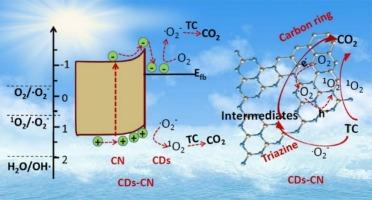亚带工程碳点/g-C3N4异质结通过双活性氧促进四环素降解
IF 4.7
3区 化学
Q2 CHEMISTRY, PHYSICAL
Journal of Photochemistry and Photobiology A-chemistry
Pub Date : 2025-09-15
DOI:10.1016/j.jphotochem.2025.116791
引用次数: 0
摘要
开发具有增强可见光吸收和电荷分离效率的无金属光催化剂是解决环境污染的关键。在此,我们提出了一种局部石墨化辅助合成碳点(CDs)集成g-C3N4异质结(CDs- cn),具有定制的子带状态和优化的界面电荷动力学。CDs- cn杂化物表现出独特的管状形态,显著增加了可见光吸收,并促进了电子从g-C3N4到CDs的快速转移。该创新设计在可见光照射下40 min内实现了86.0%的四环素(TC)降解,其动力学常数(k = 0.0457 min−1)分别是原始g-C3N4和纯cd的4.7倍和76.2倍。光电化学分析和自由基捕获实验表明,肖特基异质结驱动空间分离的电子-空穴对:CDs上的电子将O2还原为超氧自由基(·O2−),而g-C3N4上的空穴与·O2−反应生成单线态氧(1O2),通过去甲基化和开环途径协同矿化TC。值得注意的是,cd - cn在5个周期内保持了90%的活性,表现出卓越的稳定性。这项工作为抗生素废水修复提供了一种绿色,无金属异质结设计,将先进材料工程与可持续环境应用联系起来。本文章由计算机程序翻译,如有差异,请以英文原文为准。

Sub-band engineered carbon dots/g-C3N4 heterojunction for boosting tetracycline degradation via dual reactive oxygen species
The development of metal-free photocatalysts with enhanced visible-light absorption and charge separation efficiency is critical for addressing environmental pollution. Herein, we present a Localized graphitization-assisted synthesis of carbon dots (CDs)-integrated g-C3N4 heterojunctions (CDs-CN), featuring tailored sub-band states and optimized interfacial charge dynamics. The CDs-CN hybrid exhibits a unique tubular morphology, significantly extending visible-light absorption and facilitating rapid electron transfer from g-C3N4 to CDs. This innovative design achieves 86.0 % tetracycline (TC) degradation within 40 min under visible light irradiation, with a kinetic constant (k = 0.0457 min−1) 4.7-fold and 76.2-fold higher than pristine g-C3N4 and pure CDs, respectively. Photoelectrochemical analysis and radical trapping experiments reveal that the Schottky heterojunction drives spatially separated electron-hole pairs: electrons on CDs reduce O2 to superoxide radicals (·O2−), while holes on g-C3N4 react with ·O2− to generate singlet oxygen (1O2), synergistically mineralizing TC through demethylation and ring-opening pathways. Remarkably, CDs-CN retains >90 % activity over five cycles, demonstrating exceptional stability. This work provides a green, metal-free heterojunction design for antibiotic wastewater remediation, bridging advanced material engineering with sustainable environmental applications.
求助全文
通过发布文献求助,成功后即可免费获取论文全文。
去求助
来源期刊
CiteScore
7.90
自引率
7.00%
发文量
580
审稿时长
48 days
期刊介绍:
JPPA publishes the results of fundamental studies on all aspects of chemical phenomena induced by interactions between light and molecules/matter of all kinds.
All systems capable of being described at the molecular or integrated multimolecular level are appropriate for the journal. This includes all molecular chemical species as well as biomolecular, supramolecular, polymer and other macromolecular systems, as well as solid state photochemistry. In addition, the journal publishes studies of semiconductor and other photoactive organic and inorganic materials, photocatalysis (organic, inorganic, supramolecular and superconductor).
The scope includes condensed and gas phase photochemistry, as well as synchrotron radiation chemistry. A broad range of processes and techniques in photochemistry are covered such as light induced energy, electron and proton transfer; nonlinear photochemical behavior; mechanistic investigation of photochemical reactions and identification of the products of photochemical reactions; quantum yield determinations and measurements of rate constants for primary and secondary photochemical processes; steady-state and time-resolved emission, ultrafast spectroscopic methods, single molecule spectroscopy, time resolved X-ray diffraction, luminescence microscopy, and scattering spectroscopy applied to photochemistry. Papers in emerging and applied areas such as luminescent sensors, electroluminescence, solar energy conversion, atmospheric photochemistry, environmental remediation, and related photocatalytic chemistry are also welcome.

 求助内容:
求助内容: 应助结果提醒方式:
应助结果提醒方式:


